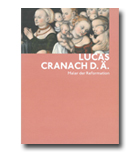
| Article number | 16889 |
| Price | 9,80 € |
LUCAS CRANACH D.Ä. - Painter of the Reformation | published in occasion of the presentation of the collection in the Hamburger Kunsthalle 2017
catalogue of the collection | 64 pages | 37 illustrations | softcover | german edition
The year 2017 is marked by the 500th anniversary of the Reformation. A presentation in the Collection of Old Masters is dedicated to this significant event.
Already in 1509 the Nuremberg humanist Christoph Scheurl enthusiastically described Lucas Cranach the Elder in a letter to him as one of most distinguished artists of his time, with regard to his talent and exemplary virtues: “Truly, with the exception of the one and only Albrecht Dürer, my fellow countryman, this undoubtedly great genius, then for this century it is only to you that is granted […] the first place in painting.
Born around 1472 in Kronach, Cranach the Elder was appointed court painter by Frederick the Wise and was called to Wittenberg in 1505, where he worked for the Saxon electors continuously for almost 50 years. In his flourishing workshop he completed a great number of prestigious commissions, including numerous portraits of the Saxon rulers. In recognition of his merits, in 1508 the elector awarded him a coat of arms featuring a winged snake with a ruby ring in its jaws, which Cranach from then on used as a signature and cachet for his paintings. Aside from this, he worked as a graphic artist, book printer, politician and entrepreneur, which made him a successful and influential citizen of Wittenberg beyond his artistic career. In 1512 he acquired a license to sell wine, became a councillor and town treasurer, owned a printing shop (from 1522 to 1526) and from 1520 a pharmacy that also boasted luxury goods such as spices, sugar and wax.
Through his close friendship with Martin Luther and based on the innovative Protestant imagery of his works, Cranach substantially contributed to the propagation of the new teachings und thus influenced the Reformation in Germany. Owing to the considerable number of portraits he produced of Martin Luther and Philipp Melanchthon, Cranach the Elder also had a formative impact on the image of the two Reformers. In 1519 he illustrated pamphlets that severely criticised the policies of the Catholic Church.
At the same time, he nonetheless occasionally accepted commissions from Roman Catholic dignitaries, as for example from Cardinal Albert of Brandenburg, and created picture cycles featuring traditional Catholic themes. In order to fulfil the numerous commissions, from the mid-1520s on, he developed standardised work processes and a clearly determined distribution of tasks among the qualified colleagues. Cranach’s tremendous productivity and rapid working method earned him the designation pictor celerrimus (fastest painter).
After his death in Weimar in 1553, his son Lucas Cranach the Younger continued the work in the studio.

